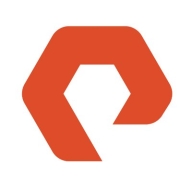


Find out in this report how the two All-Flash Storage solutions compare in terms of features, pricing, service and support, easy of deployment, and ROI.


Pure Storage FlashArray//X is the world’s first enterprise-class, all-NVMe flash storage array. It represents a new class of storage – shared accelerated storage, which is a term coined by Gartner – that delivers major breakthroughs in performance, simplicity, and consolidation.
NetApp FAS series is an enterprise-level storage system that provides a wide variety of data management services, including data protection, block and file storage, and data management.
NetApp FAS is designed to be highly scalable, allowing your organization to grow storage capacity on demand. NetApp FAS also supports multiple protocols, including NFS, SMB, iSCSI, and Fibre Channel, as well as various storage architectures, including SAN (Storage Area Network) and NAS (Network-Attached Storage).
The FAS series has multiple data protection and data management features, including snapshots, cloning, replication, and deduplication, to help secure your data and manage it more efficiently. The system integrates with other NetApp products and solutions, to create a unified data management platform. The system can be deployed on-premise, on multi-cloud environments, or hybrid.
NetApp FAS Series Benefits and Features
NetApp FAS series provides its users with several key benefits and features, including:
Reviews from Real Users
NetApp FAS Series stands out among its competitors for a number of reasons. Several major ones are its speed, reliability, and a wide variety of features.
Adriano S., IT project and infrastructure service manager, writes, “The replication feature is noteworthy because it's faster than most and it uses little bandwidth. Then there's the friendly interface that the equipment offers. With this interface, it is very easy to manage.”
Temitope O., a NetApp product manager at Hiperdist Ltd, says, “I like the unified management feature because sometimes you end up running a single protocol on the entire system. You rather have a system for a particular protocol and another system for other protocols, especially in a big environment like mine.”
Pavilion HyperParallel Data Platform
The Pavilion HyperParallel Data Platform™ dramatically accelerates what organizations achieve by delivering universally unmatched storage performance, in an incredibly compact solution while reducing data center costs and complexity. Unrivaled flexibility for multiple data types and protocols, along with broad ecosystem integration, ensure that every customer has choice and control.
What is the Pavilion HyperParallel Data Platform
The Pavilion HyperParallel Data Platform is comprised of the Pavilion HyperParallel Flash Array™ and Pavilion HyperOS™. The Pavilion HyperParallel Flash Array leverages a unique, switch-based architecture to create a multi-controller solution that delivers an unmatched combination of high performance, ultra-low latency, and storage density. Pavilion HyperOS is a powerful, purpose-built storage operating system designed to unlock the power of the multi-controller Pavilion HyperParallel Flash Array, which delivers scalability and flexibility that no other solution can offer.
Pavilion HyperParallel Data Platform Data Sheet
Download the Pavilion HyperParallel Data Platform data sheet. Updated: December 2020
We monitor all All-Flash Storage reviews to prevent fraudulent reviews and keep review quality high. We do not post reviews by company employees or direct competitors. We validate each review for authenticity via cross-reference with LinkedIn, and personal follow-up with the reviewer when necessary.